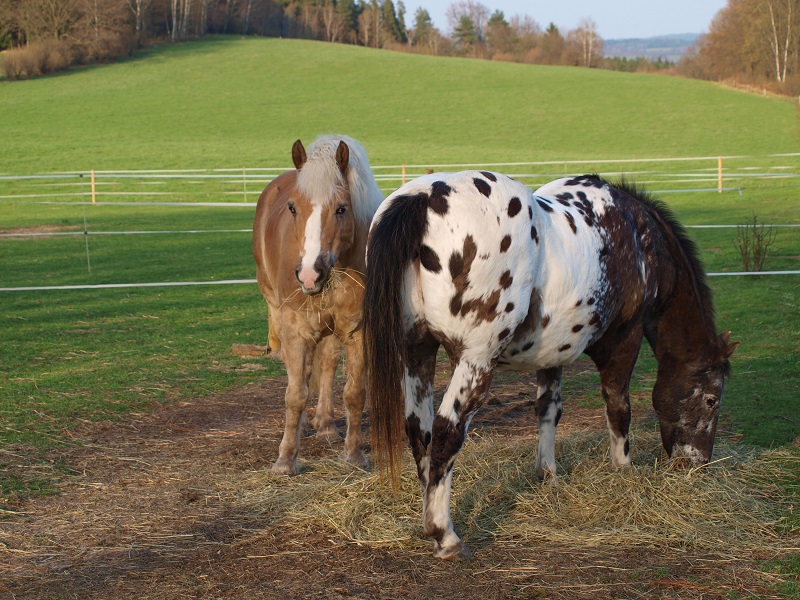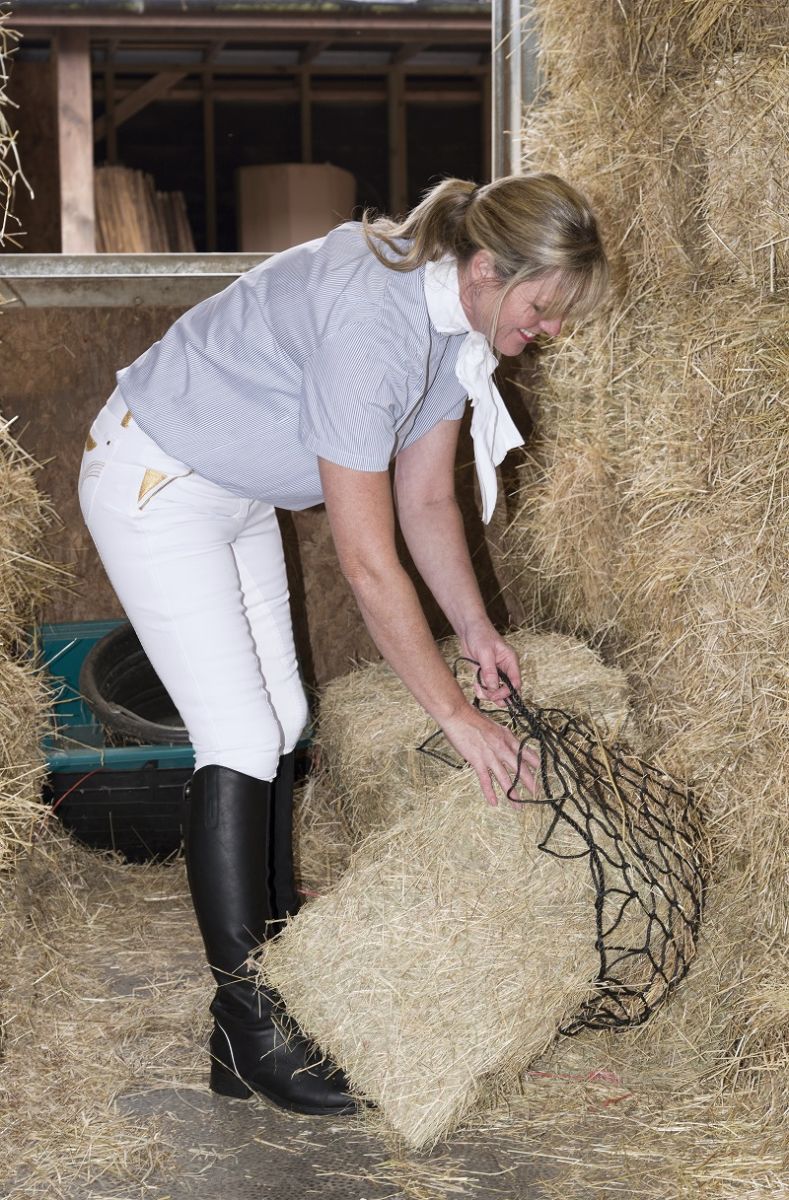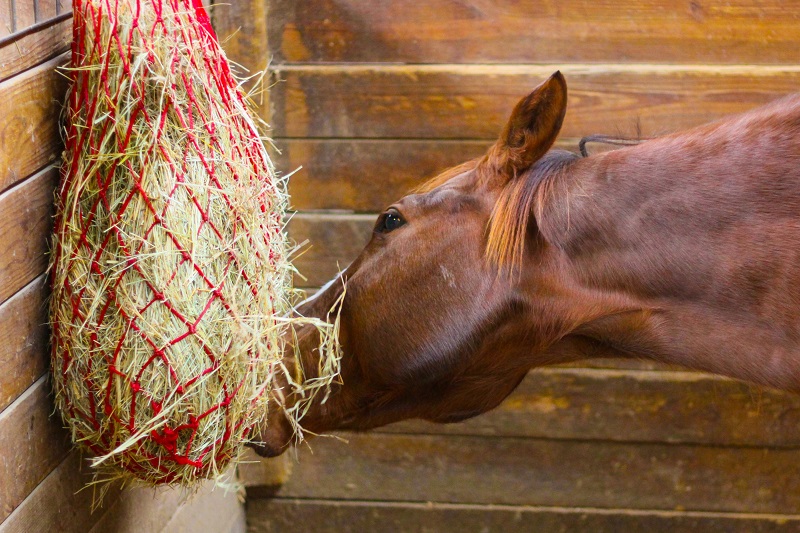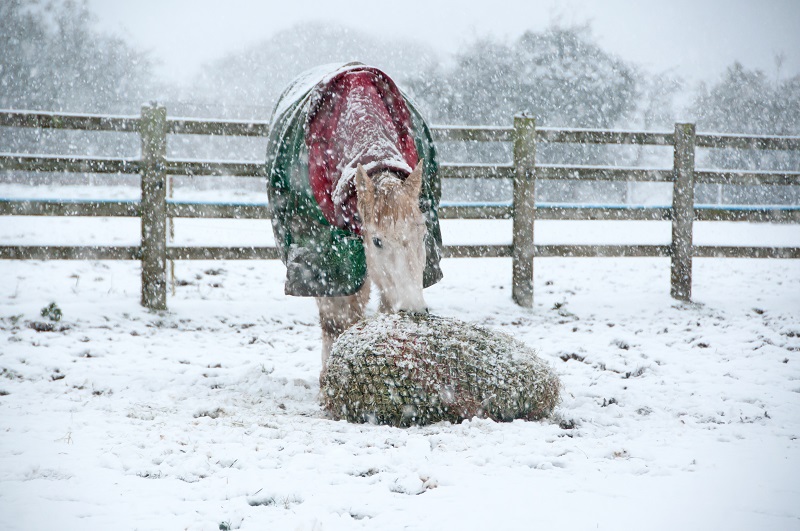Should You Wet Hay Before Feeding to Horses
By Shelagh Niblock, PAS
Horse owners have been wetting or soaking hay as a feed management practice for many years. Soaking hay for horses can be invaluable when feeding a hay that is a little dusty as a result of soil contamination or where it was stored in the barn. Horses that have allergies and are sensitive to the natural dust and particles in hay can benefit significantly from wetting or soaking hay.
In recent years, horse owners have become more aware of the impact of rapidly digestible carbohydrates in the diets of their horses. We now know that high intakes of water soluble carbohydrates (as indicated on a lab analysis as WSC or water soluble carbohydrates and including sugars and starches) can be a liability for some horses.
Not all hay has high WSC, and not all horses need to consume a diet with limited starches and sugars. But the fact is that as our horses live longer and are fed forages with better nutritional quality, we are seeing more and more of them who are overweight or afflicted with metabolic conditions such as Insulin Resistance (IR), Equine Metabolic Syndrome (EMS), or Pituitary Pars Intermedia Deficiency (PPID or Equine Cushings Disease). Horses with Polysaccharide Storage Myopathy (PSSM), a genetic condition that affects how the horse stores glucose as glycogen in the muscle, also need a diet low in sugar and starch. Too much sugar in the diets of these horses causes them to "hit the wall" when working hard. They often have no energy and can even go into a metabolic crisis and experience painful tying-up episodes if consuming a diet with too much rapidly digestible carbohydrate.

As horses live longer and consume better quality forage than in the past, more of them are becoming overweight or suffering from metabolic conditions. Horse owners are seeking to better manage the intake of water soluble carbohydrates in their horses' diets, and an effective way to do that is by soaking the hay in water. Photo: Canstock/Hanatipplova
The hay we feed our horses has undergone years of genetic selection so as to provide commercial forage growers with grasses that have superior nutrient content, high yield, and good stress tolerance. The agronomic practices including cultivation, and water and fertilizer applications under which these forages are grown, all affect their nutritional analysis. Increasing numbers of horse owners are availing themselves of this superior forage in the form of hay, only to find that it's almost too good for the average horse. Grass hays in Western Canada are known for their superior digestibility and excellent energy content. At least part of that energy is due to high sugar content.
The potential impact of this on our horses has focused more scrutiny on how to better manage a potentially high sugar hay as part of a healthy diet. Soaking hay before consumption has been proven in peer reviewed research trials to be an effective way to reduce the content of water soluble carbohydrate in the hay.
What is the Best Way to Soak Hay?
Soaking hay is as simple as that. Before feeding, the hay is submerged in water for a prescribed period of time, then pulled out of the water and fed. Sounds simple, doesn't it? It actually is simple once you have a good routine down for doing it, but there are many questions about how best to do it, and plenty of misinformation out there about expected outcomes.
Related: Iron in the Equine Diet

An easy method of soaking hay is to fill a hay net, then submerge it in a large garbage or plastic tote filled with clean water. Research has shown that soaking grass hay in cool water for 60 minutes before consumption will effectively reduce the content of water soluble carbohydrates by 30 to 40 percent. Photo: Shutterstock/Peter Titmuss
A research trial was conducted by Dr. Krishona Martinson, an equine forage specialist at the University of Minnesota, on how long hay needs to be soaked to remove significant levels of WSC. Her experiment included several different kinds of hay, including orchard grass at different maturities.
In her research, Dr. Martinson was able to establish good practical guidelines for soaking hays. She found that soaking for 60 minutes in cool water removed 30 to 40 percent of the WSC in the grass hays depending on the maturity of the hay, without removing significant amounts of other nutrients such as phosphorous, magnesium, and potassium. Soaking for longer than one hour removed more WSC, but it also removed more of the other nutrients we feed hay to provide. She found that protein was not significantly changed no matter how long the hay was soaked, and calcium was also somewhat resistant to loss by soaking.
Researcher Katy Watts of Safer Grass suggests that the more water you use when soaking hay, the more you can influence the dilution gradient. This means you can potentially remove more WSC in the same period of time. In other words, more water means more removal of WSC from your hay. A word of caution though, more water can also result in higher removal of other nutrients as well.
All soaked hay will start to spoil when wet. This is particularly true in hot weather, therefore, more management is required when feeding soaked hay in the summer. Meals need to be smaller and fed more frequently to avoid the risk of feeding hay that is close to spoiling. Be scrupulous about your soaking protocol, using only clean potable water and a soaking container that is clean and free of soil, refuse or manure.

Both soaking and steaming hay can be of significant benefit to horses with allergies or sensitivities to dust. Steaming hay for 50 to 90 minutes improves palatability and significantly reduces mold spores and dust. Steaming hay also removes far less of the nutrients that are leached out by soaking. Photo: Shutterstock/ShannonJordan
If you are feeding soaked hay in very cold weather it will freeze in the net more quickly. This again calls for more management for the horse owner, including feeding smaller meals more frequently.
What's the Most Practical Way to Soak Horse Hay?
For sheer convenience, it's hard to beat soaking hay in a hay net submerged in a large garbage can or plastic tote. Remember, water volume is important. Stuffing several hay nets into one large container with minimal water will not be as effective at removing WSC as one hay net in abundant water. Choose a container that is easy to keep clean and can be stored in a clean place when not in use. After one hour of soaking, the submerged hay can be pulled out and the water disposed of on the manure pile or down a drain. If you pour it out on the ground it can attract flies and wasps in warm weather, or create an icy patch in winter. The hay can be further rinsed under the tap to remove any residual soaking water. Choose a hay net with smaller holes to avoid losing a lot of leaf in the water. As much as possible, feed the soaked hay immediately, and feed in a cool, well-ventilated place in the summer.
What are the Advantages of Steaming Hay?
Steaming hay in a commercial hay steamer is popular in the United Kingdom, and is gaining in popularity in North America. One significant advantage of feeding steamed hay instead of dry hay is the reduction in dust and mold spores that may be present. Horse owners know well to avoid feeding musty or moldy hay, but it does happen sometimes despite our best efforts. Steaming hay for 50 to 90 minutes in a commercial steamer will reduce the particulate matter in the hay, making it easier for some horses to eat. It will also render inactive many of the mold spores and possibly mycotoxins that may be present in a hay that is not the best.
Related: Breathtaking: A Close Look at Equine Respiratory Diseases

In cold weather, soaked hay should be given in smaller meals more often so it does not freeze in the net. Photo: Shutterstock/Chelle129
Is Steaming a Replacement for Soaking Hay?
Steaming hay is very effective at increasing palatability of a dry hay and it does reduce the WSC of hay somewhat, but it is not as effective as soaking for removing sugars from a hay. The good news is that steaming removes far less of the other nutrients when compared with prolonged soaking.
The effects of steaming on the availability of some of the carbohydrates sources are not yet fully understood. From a nutritional perspective, it's logical to assume that "cooking" by steaming the hay may well be making some of the complex sugars that are typically utilized in the hind gut of the horse more digestible and therefore more likely to be utilized in the foregut. This could potentially increase blood glucose and consequently stimulate an insulin response, something we want to avoid in a metabolic horse. Until more research is completed it may well be advisable to continue to soak the hay of your IR, EMS, or PPID horse, or any horse with sugar sensitivities.
Just like soaked hay, steamed hay must be fed quickly before it spoils, especially in hot weather.
Soaking hay for the metabolic or overweight horse can be a helpful management tool, especially if faced with a barn full of hay that isn't suitable for all horses in the stable. But if not done correctly, it can also be a recipe for a messy yard and a horse off its feed. If you decide that soaking hay makes sense for your horse, keep in mind that soaking longer is not always better, hot water isn't necessary, more water increases the dilution gradient for ALL nutrients, water and containers must be clean, and the spent water should be discarded in areas horses can't access.
And remember, soaked hay won't keep fresh forever. If it smells bad – don't feed it.
Related: The Chew Factor - Fibre Intake in Horse Hay
hodgettsarfeaught.blogspot.com
Source: https://www.horsejournals.com/horse-care/feed-nutrition/how-and-why-soaking-hay
0 Response to "Should You Wet Hay Before Feeding to Horses"
Post a Comment